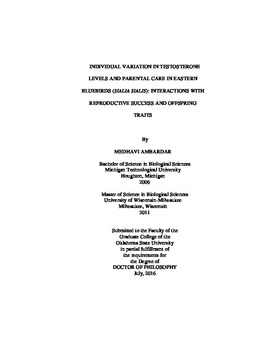| dc.contributor.advisor | Grindstaff, Jennifer | |
| dc.contributor.author | Ambardar, Medhavi | |
| dc.date.accessioned | 2017-02-22T22:08:13Z | |
| dc.date.available | 2017-02-22T22:08:13Z | |
| dc.date.issued | 2016-07 | |
| dc.identifier.uri | https://hdl.handle.net/11244/48775 | |
| dc.description.abstract | Hormones are important regulators of behavior and fitness. We have learned much about the direct effects of hormones on behavior and reproductive success from studies that experimentally manipulate hormone levels. To complement these studies, we also need to assess natural individual variation in hormones at multiple time points in relation to behavior and fitness as this practice can help to inform us about how hormonal profiles evolve. Testosterone has been implicated in fitness-related traits, and is predicted to interact with important behaviors, such as parental care. The level of parental care provided to young is critical in shaping the rearing environment. I conducted research on eastern bluebirds (Sialia sialis) to explore individual variation in testosterone levels in relation to parental care and fitness, and performed an experiment to alter parental behavior and measured subsequent effects on offspring. In Chapter II of my dissertation, I reported the findings of a study in which I injected birds with gonadotropin-releasing hormone (GnRH) to stimulate testosterone secretion within parental and aggressive contexts. I measured testosterone levels before GnRH was injected (initial testosterone levels) and thirty minutes after GnRH was injected (GnRH-induced levels), as well as the difference between these values (testosterone production). None of these testosterone measurements were related to nest visit rates or aggressive response to an intruder. However, there was significant variation among individuals in initial testosterone levels. Individuals also differed in their responsiveness to GnRH. In Chapter III, I showed that reproductive success was not related to initial testosterone levels or GnRH-induced testosterone levels. In the study conducted for Chapter IV, I manipulated brood sizes of bluebirds to create enlarged and reduced broods, keeping some broods unmanipulated as controls. Surprisingly, adults raising enlarged broods compensated for the increased number of young. As a result, the nestlings did not incur many costs overall, but nestling feather coloration was impacted. My findings emphasize the importance of studying individual variation in hormone levels, and identifying situations in which parents would be more likely to incur costs than offspring. | |
| dc.format | application/pdf | |
| dc.language | en_US | |
| dc.rights | Copyright is held by the author who has granted the Oklahoma State University Library the non-exclusive right to share this material in its institutional repository. Contact Digital Library Services at lib-dls@okstate.edu or 405-744-9161 for the permission policy on the use, reproduction or distribution of this material. | |
| dc.title | Individual variation in testosterone levels and parental care in eastern bluebirds (Sialia sialis): Interactions with reproductive success and offspring traits | |
| dc.contributor.committeeMember | Luttbeg, Barney | |
| dc.contributor.committeeMember | DuRant, Sarah | |
| dc.contributor.committeeMember | O'Connell, Tim | |
| osu.filename | Ambardar_okstate_0664D_14804.pdf | |
| osu.accesstype | Open Access | |
| dc.type.genre | Dissertation | |
| dc.type.material | Text | |
| thesis.degree.discipline | Zoology | |
| thesis.degree.grantor | Oklahoma State University | |
